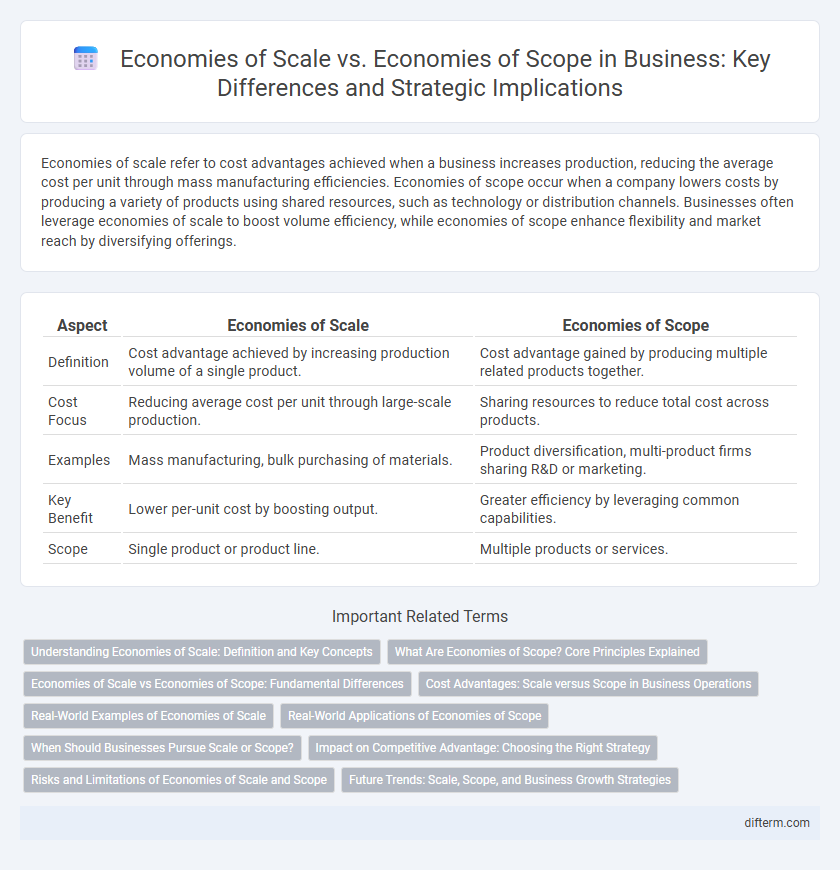Economies of scale refer to cost advantages achieved when a business increases production, reducing the average cost per unit through mass manufacturing efficiencies. Economies of scope occur when a company lowers costs by producing a variety of products using shared resources, such as technology or distribution channels. Businesses often leverage economies of scale to boost volume efficiency, while economies of scope enhance flexibility and market reach by diversifying offerings.
Table of Comparison
| Aspect | Economies of Scale | Economies of Scope |
|---|---|---|
| Definition | Cost advantage achieved by increasing production volume of a single product. | Cost advantage gained by producing multiple related products together. |
| Cost Focus | Reducing average cost per unit through large-scale production. | Sharing resources to reduce total cost across products. |
| Examples | Mass manufacturing, bulk purchasing of materials. | Product diversification, multi-product firms sharing R&D or marketing. |
| Key Benefit | Lower per-unit cost by boosting output. | Greater efficiency by leveraging common capabilities. |
| Scope | Single product or product line. | Multiple products or services. |
Understanding Economies of Scale: Definition and Key Concepts
Economies of scale refer to the cost advantages that enterprises experience as production output increases, resulting from the spreading of fixed costs over more units and operational efficiencies. Key concepts include bulk purchasing, specialized labor, and technological investments, which reduce the average cost per unit. Understanding these principles enables businesses to optimize production processes and enhance competitive advantage by minimizing costs at higher output levels.
What Are Economies of Scope? Core Principles Explained
Economies of scope refer to cost advantages that businesses achieve by producing a variety of products using shared resources, such as facilities, technology, or labor. This strategy reduces average costs by leveraging synergies across multiple product lines, enhancing operational efficiency and market competitiveness. Core principles include resource sharing, diversification, and integrated production processes to maximize value creation while minimizing expenses.
Economies of Scale vs Economies of Scope: Fundamental Differences
Economies of scale refer to cost advantages gained through increased production volume, reducing the average cost per unit as output grows. Economies of scope emphasize cost savings achieved by producing a variety of products using shared resources or capabilities. The fundamental difference lies in scale focusing on single-product cost efficiency, while scope centers on leveraging diversification for overall cost reduction.
Cost Advantages: Scale versus Scope in Business Operations
Cost advantages in business operations arise from economies of scale, which reduce average costs through increased production volume, and economies of scope, which lower costs by diversifying product lines using shared resources. Economies of scale benefit large-scale manufacturing by spreading fixed costs over more units, while economies of scope leverage operational synergies across related products to minimize expenses. Firms strategically balance these approaches to optimize cost efficiency and competitive advantage in diverse markets.
Real-World Examples of Economies of Scale
Walmart exemplifies economies of scale by leveraging its vast purchasing power to negotiate lower prices from suppliers, significantly reducing costs per unit. Amazon achieves economies of scale through its extensive fulfillment network, optimizing logistics and distribution to minimize operational expenses. Toyota benefits from economies of scale by standardizing production processes across multiple plants, lowering the average cost of manufacturing vehicles globally.
Real-World Applications of Economies of Scope
Economies of scope offer significant advantages in business by enabling firms to diversify product lines and leverage shared resources, reducing overall costs and increasing market reach. Companies like Amazon utilize economies of scope by expanding from e-commerce to cloud computing and digital streaming, optimizing asset use and enhancing competitive advantage. This strategic diversification enhances operational efficiency and drives sustainable growth across multiple sectors.
When Should Businesses Pursue Scale or Scope?
Businesses should pursue economies of scale when aiming to reduce average costs through high-volume production, benefiting industries with standardized products and significant fixed costs. Economies of scope are advantageous when firms diversify their product lines or services to leverage shared resources, expertise, or distribution channels, enhancing competitiveness in markets demanding variety. Strategic decisions hinge on market demand, cost structures, and long-term growth objectives to determine whether focusing on scale or scope maximizes profitability and operational efficiency.
Impact on Competitive Advantage: Choosing the Right Strategy
Economies of scale drive competitive advantage by reducing average costs through increased production volume, enabling businesses to lower prices and improve market share. Economies of scope enhance competitive advantage by leveraging diverse product lines to maximize resource utilization and cross-selling opportunities, strengthening brand loyalty. Selecting the right strategy depends on the firm's operational capabilities and market conditions to balance cost efficiency with product diversification.
Risks and Limitations of Economies of Scale and Scope
Economies of scale face risks such as increased operational complexity and vulnerability to market demand fluctuations, which can lead to inefficiencies and higher fixed costs. Economies of scope, while enabling cost savings through diversified product lines, risk overextension and dilution of core competencies, potentially reducing overall competitiveness. Both economies are limited by factors like resource constraints, management challenges, and the dynamic nature of market conditions affecting sustained cost advantages.
Future Trends: Scale, Scope, and Business Growth Strategies
Future trends in business growth emphasize integrating economies of scale and economies of scope to maximize operational efficiency and market reach. Companies leverage advanced technologies, such as AI and automation, to scale production while diversifying product lines to exploit scope advantages. Strategic growth now revolves around balancing high-volume cost reductions with expansive service offerings to sustain long-term competitive advantage.
economies of scale vs economies of scope Infographic

 difterm.com
difterm.com